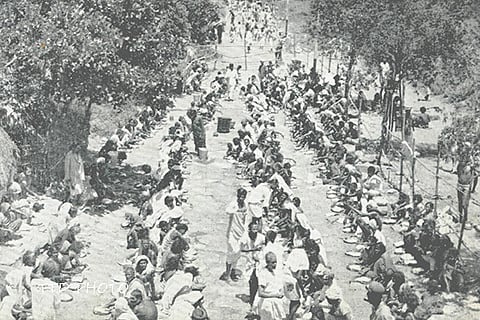- Commentary
- History Vignettes
- Notes on Culture
- Dispatches
- Podcasts
- Indian LanguagesIndian Languages
- Support

Note: This essay is excerpted from the seminal work on the Indian tradition of food sharing titled “Annam Bahukurvita” authored by Dr. J K Bajaj and Dr. M D Srinivas. The original title of the essay in the book is “Straying from the Discipline: The Memory Abides.”
Not so long ago, when mother would sit down to prepare rotis, we, the children of the house, gathered around the hearth and watched. She would take the first ball of dough, touch it with a little ghee, and give it to one of us, to run into the street, find a cow and put the ball of dough in her mouth. Only then would mother put the griddle on the fire; and next she would take a rather small bit of dough, dip it in ghee, wipe the griddle with it, and leave it on the side, to be offered to the ants or the crows later.
The next full ball of dough was rolled into a roti and put onto the griddle. But this first roti mother would cook only on one side, touch it with a little mustard oil, and then it was the turn of another one of us to run and offer it to a dog. The next two rotis were cooked and kept aside for the Gurudvara along with a bowl of the day’s vegetable curry or dal. Later, the wife of the Gurudvara priest would come and collect her share. She collected such offerings from perhaps forty houses, and that would have probably sufficed for her family as well as the occasional guest who sought shelter in the Gurudvara.
We were young then, and our appetite used to be sharp. But howsoever hungry we might have been, we had to wait for mother to take out the share of the cow, the crow, the dog and the Gurudvara, before being served. And, in spite of the gnawing feeling of hunger in our stomachs, it somehow felt good to wait. The touch of the warm and wet tongue of the cow as she slurped the ball of dough out of our young hands felt distinctly like a blessing. Offering a specially cooked roti to a stray dog filled us with a satisfying feeling of warmth. And when the wife of the Gurudvara priest came to collect her share, the food and the house seemed to have been sanctified.
This was not the only food that was shared out from our otherwise simple home, where lunch or dinner almost invariably consisted of a single dal or a vegetable curry to go with the rotis. But the beggars, of whom about four or five used to call at our door every day, were always given a handful of flour each. This too was a job for us, the children, and taking out a handful from the pot of flour and pouring it into the cloth bag of the beggar, thoroughly soiling the hand with the flour in the process, used to be a pleasure in itself. Like the wife of the Gurudvara priest, the cleaning lady also came and collected her share of rotis and occasionally a small serving of curry or dal. And it seemed as if food was flowing all day: mother considered it to be an unimaginably bad omen for the vessel of flour or the box of rotis to get completely empty. At night, when all food was exhausted, mother would make it a point to leave a small bit of roti in the box.
As we began to grow older, this flow of food began to ebb. The wife of the Gurudvara priest began to feel shy about going around collecting food: she preferred the Gurudvara’s share to be offered in money. The roti for the lady who cleaned the streets began to seem too expensive: it was replaced with a substantial increase in our share of her monthly wages, which of course remained much below the price of a roti a day even after the increase. The handful of flour for the beggars was substituted with a five or ten paisa bit, and later even this inconsequential bit of money came to be grudged, and the beggars more or less stopped coming. And as we began to get educated, and learnt about the new ways, the roti for the cow and the dog began to look like wanton waste of good food. And the insistence on keeping the pot flowing seemed like some silly superstition.
Times seem to have changed thus in the last thirty or forty years. What mother used to do was of course a highly abbreviated version of what Indians of a more affluent period would have done. She was not performing Pancamahayajna as Manu would have prescribed it, nor taking out substantial shares for all, as the people of Chengalpattu did in the eighteenth century. Most Indians, as we shall see, had probably lost the prosperity and plenty essential for undertaking the kind of observance that encompasses the whole of creation in its generosity.
Yet she was keeping the memory alive. And perhaps till very recently many of the Indians, though not the relatively resourceful ones, were trying to somehow keep to at least the form of the discipline of sharing before eating that seems to be such an essential characteristic of being Indian. They were in no position to follow what they remembered to be the discipline. But they cherished the memory. The memory remained sacred.
(Republished with the author’s permission)
The Dharma Dispatch is now available on Telegram! For original and insightful narratives on Indian Culture and History, subscribe to us on Telegram.
